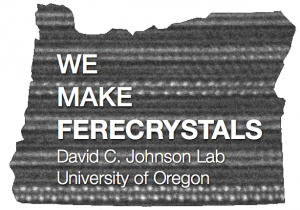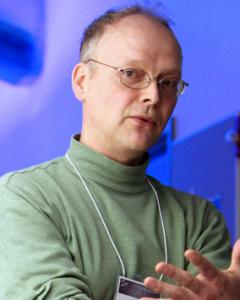Johnson is both an entrepreneur and educator, and has worked extensively with the Engineering and Technology Industry Council to create research and educational programs with Oregon Industries. He led MSI’s efforts to create the Graduate Internship Program (Industrial Internship Graduate degree program). This program now partners with over 60 companies as well as universities and colleges across the country, providing both Masters and Ph.D. students in chemistry and physics at the University of Oregon with opportunities to spend 6-9 months as engineers and research scientists solving problems in an industry setting or to spend a quarter or semester as an instructor at a primarily undergraduate institution. These internships build skills and provide experience that lead to informed career decisions and opportunities for the participating students. Industry in the Northwest has benefited short term from the productivity of the interns and long term from gaining outstanding employees. The relationships formed setting up the Graduate Internship program formed the basis of the government, industry, and academic research collaborations that developed into ONAMI, the Oregon Nanoscience and Microtechnologies Institute. ONAMI promotes collaboration between scientists at UO, OSU, PSU, PNNL, and Oregon Industries. Johnson was one of the founding faculty directors of ONAMI.
Johnson has also been a leader in successful National Science Foundation IGERT [5] and GK-12 programs as well as U.S. Dept. of Education Graduate Assistance in Areas of National Need awards. The IGERT program supports graduate students collaborating between Materials Science Institute (MSI) research groups and facilitates Ph.D. students obtaining internships with partnering companies. The GK-12 and GAANN programs partner with the Umatilla-Morrow and North Central Educational Service Districts. Ph.D. students become scientists-in-residence in schools served by these ESDs, training teachers in the use of inquiry based science kits in their classrooms. Through ONAMI and the Engineering and Technology Industry Council, Johnson has strengthened ties between local industry and the University of Oregon and between the University of Oregon and PSU and OSU [6]. Working with Vice Provost Rich Linton, Johnson was able to provide both industry and fellow academics access to expensive materials characterization equipment through the establishment of CAMCOR – the Center for Advanced Materials Characterization in Oregon . CAMCOR is Oregon’s high tech extension service and is located in the new Lokey Labs facility which is a factor of two below the NIST A criteria for vibrations at all frequencies and has exceptional temperature stability. [7] [8]
Johnson’s research group benefits from collaborating with researchers at other institutions, who probe the physical properties and electronic structures of the new compounds they prepare. For example, the discovery and understanding of tungsten diselenide with the lowest thermal conductivity ever reported for a dense solid depended on thermal conductivity measurements by Professor Cahill’s group at the University of Illinios, diffraction data and analysis done with Dr. Zschack of the Advanced Photon Source at Argonne National Laboratory, and calculations performed by Professor Keblinski of Rochester Institute of Technology. More recently, collaborations with the Franhofer Institute in Freiburg Germany have enabled Johnson’s group to develop an equilibrium based approach to control the carrier concentration of nanostructured compounds.
More recently, Johnson collaborated with Douglas Keszler, OSU, John Wager, OSU, and Darren Johnson, UO on a successful proposal to the National Science Foundation for a Chemical Innovation Center. [8] [9] The Center for Sustainable Materials Chemistry, funded in October 2008, studies and expands a transformational solution-based chemistry platform developed by the team that will allow electronics manufacturers to:
– fabricate high-performance devices via low temperature deposition,
– pattern inorganic materials with an unprecedented combination of high resolution, high speed, and large area,
– reduce the production of waste,
– optimize device performance, and
– enable transformational fundamental chemistry,
– creating new green technology.
To contact Dave: davej@uoregon.edu

